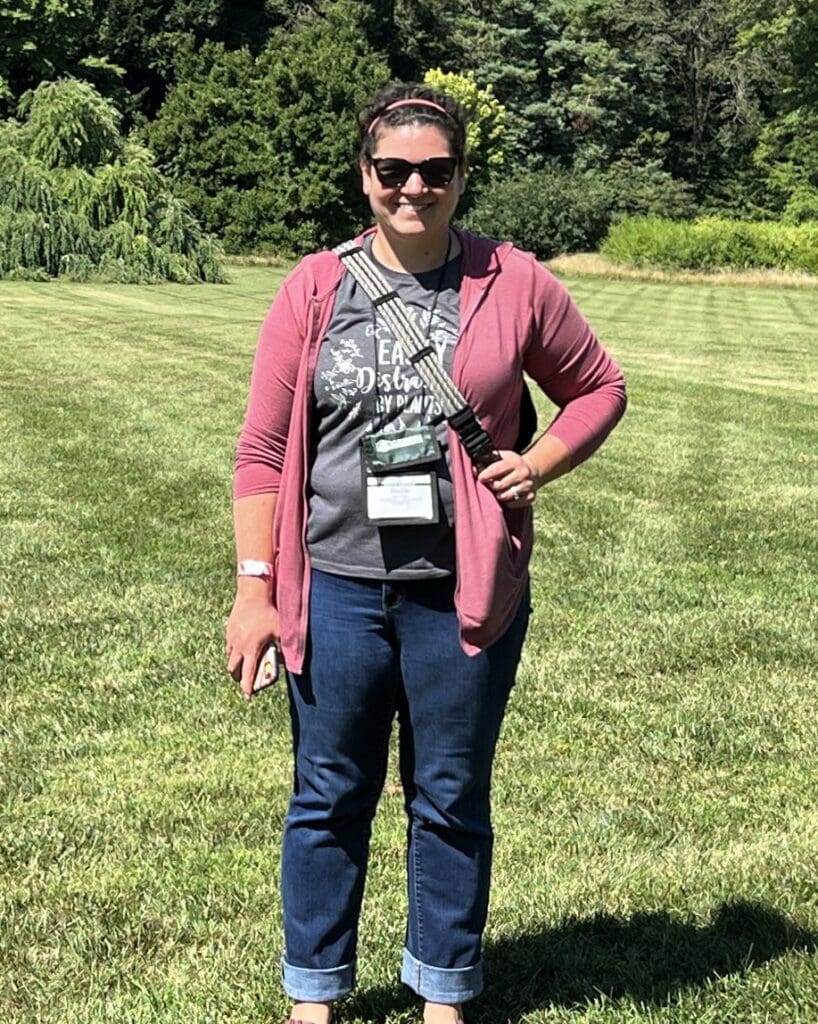September 2024
by Anne Clippinger
In January of 2024, the Cathedral community was fortunate when Adrienne Schopf took the reins as Head of Horticulture, succeeding the wonderful Sandy Flowers, who retired at the end of last year. Addie came to the Cathedral in 2015 after a stint at Tudor Place in Georgetown, and spent the past several years as Bishop’s Gardener, so she hit the ground running. She reports that the job is really fun but has “many moving pieces.”

An Iowa native with a horticulture degree from Iowa State University, Addie was drawn to Washington, DC, because of her interest in historical gardens. Something she particularly values about the Cathedral Close is that while there is a rich history and a mission to honor the vision of the original designers, Frederick Law Olmsted, Jr. and Florence Bratenahl, in collaboration with All Hallows Guild’s Garden Committee, she is not constrained by a specific plant list. This “keeps things interesting, keeps people engaged, and and allows them to try new things.”
This summer, one of the hottest on record, has been a challenge for everyone. Addie reports that with the first 100-degree day coming in mid-June, irrigation has been a constant activity, leaving little time for regular maintenance tasks. The heat stresses the ‘60s-era irrigation system in the Bishop’s Garden, and many areas of the Close require hand-watering. All summer, she says, everyone was “running around moving sprinklers.” Fortunately August, when storms sometimes bring too much rain, was relatively normal. Now, with cooler weather, the crew is weeding, planting, and addressing projects requested by the Close schools. The grass is growing again, and the turf crew is busy.
Addie expressed appreciation for this year’s summer interns, sponsored by All Hallows Guild in partnership with the Stanley Smith Horticultural Trust. Izzie Della Santa, a student at the University of Maryland’s Environmental Science program, and Anna Bolejack, from Virginia Tech’s Landscape Architecture program, provided vital assistance in the Bishop’s Garden; and this year we had our first Turf Intern, Devin Jones, a recent University of Maryland graduate. Addie says the interns were quick studies, and the staff is very grateful for their help through this challenging summer.
Current priorities on the Close include continuing to replace the 40-plus trees lost in a devastating storm in the summer of 2023. In some cases, this means finding new planting locations, and even new varieties of trees. An example is the Apse Grove, an AHG project at the Cathedral’s south end, where several oaks were lost. The staff will experiment with “new to us” Southern cultivars, which should be better able to withstand our warmer winters to come. Also, the Apse area includes new flower beds planted with native cultivars. While the Bishop’s Garden incorporates more stone and lends itself to a formal design, the staff increasingly looks for other areas to plant more natives, which attract pollinators and and can adapt more easily to climate change. “You can’t have too many natives,” says Addie. Even in more formal areas, sometimes she needs to explain that new native cultivars aren’t necessarily wild and tall, and can accommodate more formality. She enjoys the challenge of encouraging our community to include more natives, and to think beyond the flower season. There is much room for creativity in respecting our historical concept while adapting to present and future conditions.
Visitors may surprise a bunny in the Bishop’s Garden and Addie says that’s ok, up to a point. Rabbits can be destructive, and a few years ago they were a real problem. But by choosing plants less attractive to them, the staff can fend off overpopulation. Also, Addie has seen evidence of a fox den on the Close! Natural predators are encouraged rather than chemicals or other artificial methods of pest control. This year, says Addie, we have more chipmunks, who are less destructive, and in her opinion, cuter; but of course cuteness is in the eye of the beholder. The goal is a natural balance and a healthy environment, and we are all grateful to our knowledgeable horticulture team for preserving that.


